Quantifying Innovation: Intellectual Property Data as Indicators of Technology Maturity of Metal–Organic-Frameworks and Inorganic Nanoparticles
Abstract
1. Introduction
2. Materials and Methods
3. Results
3.1. Technological Landscape
3.2. Patents Lifespan and Scope Year Index
3.3. Citations
4. Discussion
5. Conclusions
Author Contributions
Funding
Data Availability Statement
Acknowledgments
Conflicts of Interest
Abbreviations
| SY | Scope–Year Index |
| MOF | Metal–Organic Frameworks |
| iNP | Inorganic Nanoparticle |
| GDP | Gross Domestic Product |
| IPC | International Patent Classification |
| PCT | Patent Cooperation Treaty |
| WIPO | World Intellectual Property Organization |
| TRL | Technology Readiness Level |
Appendix A
| Technology | Query |
|---|---|
| Metal–organic frameworks (MOFs) | Title abstract claims = ((MOF) or (MOFs)) or (metal–organic-framework *) |
| AND | |
| Title abstract claims = (bio * or medic * or therap * or (in vivo) or (in vitro) or pharma * or cure *) | |
| AND | |
| Application date ≤ 2020 | |
| Inorganic Nanoparticles (iNPs) | Title abstract claims = (magnetic * nanoparticle *) or (plasmonic * nanoparticle *) or (iron oxide nanoparticle *) |
| AND | |
| Title abstract claims = (bio * or medic * or therap * or (in vivo) or (in vitro) or pharma * or cure * or Diagnostic * or diagnosi * or theranostic) | |
| AND | |
| Application date ≤ 2020 |
References
- Bornmann, L.; Marx, W. How Good Is Research Really? EMBO Rep. 2012, 14, 226–230. [Google Scholar] [CrossRef]
- Granstrand, O. The Economics and Management of Intellectual Property; Edward Elgar Publishing: Cheltenham, UK, 1999. [Google Scholar]
- WIPO. WIPO Intellectual Property Handbook: Policy, Law and Use; World Intellectual Property Organization: Geneva, Switzerland, 2017. [Google Scholar]
- Adelman, M.J. The New World of Patents Created by the Court of Appeals for the Federal Circuit. Univ. Mich. J. Law Reform 1986, 20, 979. [Google Scholar] [CrossRef]
- Arora, A. Licensing Tacit Knowledge: Intellectual Property Rights and the Market for Know-How. Econ. Innov. New Technol. 1995, 4, 41–60. [Google Scholar] [CrossRef]
- Browne, D.; O’Mahony, M.; Caulfield, B. How Should Barriers to Alternative Fuels and Vehicles Be Classified and Potential Policies to Promote Innovative Technologies Be Evaluated? J. Clean. Prod. 2012, 35, 140–151. [Google Scholar] [CrossRef]
- Hall, B.H.; Ziedonis, R.H. The Patent Paradox Revisited: An Empirical Study of Patenting in the U.S. Semiconductor Industry, 1979–1995. Rand J. Econ. 2001, 32, 101–128. [Google Scholar] [CrossRef]
- Kunamneni, A.; Plou, F.J.; Ballesteros, A.; Alcalde, M. Laccases and Their Applications: A Patent Review. Recent Pat. Biotechnol. 2008, 2, 10–24. [Google Scholar] [CrossRef] [PubMed]
- Liu, C.-Y.; Wang, J.-C. Forecasting the Development of the Biped Robot Walking Technique in Japan through S-Curve Model Analysis. Scientometrics 2010, 82, 21–36. [Google Scholar] [CrossRef]
- Liu, K.; Chen, C.-H. Formulation of Research and Development Strategy by Analysing Patent Portfolios of Key Players the Semiconductor Industry According to Patent Strength and Technical Function. World Pat. Inf. 2022, 70, 102125. [Google Scholar] [CrossRef]
- Mejia, C.; Kajikawa, Y. Emerging Topics in Energy Storage Based on a Large-Scale Analysis of Academic Articles and Patents. Appl. Energy 2020, 263, 114625. [Google Scholar] [CrossRef]
- Oltra, V.; Saint Jean, M. Variety of Technological Trajectories in Low Emission Vehicles (LEVs): A Patent Data Analysis. J. Clean. Prod. 2009, 17, 201–213. [Google Scholar] [CrossRef]
- Paliwal, R.; Paliwal, S.R.; Kenwat, R.; Das Kurmi, B.; Sahu, M.K. Solid Lipid Nanoparticles: A Review on Recent Perspectives and Patents. Expert Opin. Ther. Pat. 2020, 30, 179–194. [Google Scholar] [CrossRef]
- Shubbak, M.H. Advances in Solar Photovoltaics: Technology Review and Patent Trends. Renew. Sustain. Energy Rev. 2019, 115, 109383. [Google Scholar] [CrossRef]
- Visser’s Annotated European Patent Convention; Visser, D., Lai, L., de Lange, P., Suominen, K., Eds.; Kluwer, Wolters: Alphen aan den Rijn, The Netherlands, 2019. [Google Scholar]
- Xu, S.; Mariani, M.S.; Lü, L.; Napolitano, L.; Pugliese, E.; Zaccaria, A. Citations or Dollars? Early Signals of a Firm’s Research Success. Technol. Forecast Soc. Change 2024, 201, 123208. [Google Scholar] [CrossRef]
- Van Pottelsberghe De La Potterie, B.; Van Zeebroeck, N. A Brief History of Space and Time: The Scope-Year Index as a Patent Value Indicator Based on Families and Renewals. Scientometrics 2008, 75, 319–338. [Google Scholar] [CrossRef]
- Hu, Z.; Zhou, X.; Lin, A. Evaluation and Identification of Potential High-Value Patents in the Field of Integrated Circuits Using a Multidimensional Patent Indicators Pre-Screening Strategy and Machine Learning Approaches. J. Informetr. 2023, 17, 101406. [Google Scholar] [CrossRef]
- Carregal-Romero, S.; Guardia, P.; Yu, X.; Hartmann, R.; Pellegrino, T.; Parak, W. Magnetically Triggered Release of Molecular Cargo from Iron Oxide Nanoparticle Loaded Microcapsules. Nanoscale 2015, 7, 570–576. [Google Scholar] [CrossRef]
- Liu, H.; Xu, C.; Meng, M.; Li, S.; Sheng, S.; Zhang, S.; Ni, W.; Tian, H.; Wang, Q. Metal-Organic Framework-Mediated Multifunctional Nanoparticles for Combined Chemo-Photothermal Therapy and Enhanced Immunotherapy against Colorectal Cancer. Acta Biomater. 2022, 144, 132–141. [Google Scholar] [CrossRef]
- Picchi, D.; Biglione, C.; Horcajada, P. Nanocomposites Based on Magnetic Nanoparticles and Metal-Organic Frameworks for Therapy, Diagnosis, and Theragnostics. ACS Nanosci. 2023, 4, 85–114. [Google Scholar] [CrossRef]
- Rojas, S.; Arenas-Vivo, A.; Horcajada, P. Metal-Organic Frameworks: A Novel Platform for Combined Advanced Therapies. Coord. Chem. Rev. 2019, 388, 202–226. [Google Scholar] [CrossRef]
- Sorraya, L.; Biglione, C.; Horcajada, P. Advances in Plasmonic-Based MOF Composites, Their Bioapplications and Perspectives in This Field. Expert Opin. Drug Deliv. 2022, 19, 1417–1434. [Google Scholar]
- Clarivate Web of Science Platform. Available online: https://clarivate.com/products/scientific-and-academic-research/research-discovery-and-workflow-solutions/webofscience-platform/ (accessed on 1 August 2024).
- Guellec, D.; Van Pottelsberghe de la Potterie, B. Applications, Grants and the Value of Patent. Econ. Lett. 2000, 69, 109–114. [Google Scholar] [CrossRef]
- Ding, M.; Yu, W.; Zeng, T.; Wang, S. PTNS: Patent Citation Trajectory Prediction Based on Temporal Network Snapshots. Sci. Rep. 2024, 14, 24034. [Google Scholar] [CrossRef] [PubMed]
- Song, H.; Hou, J.; Zhang, Y. The Measurements and Determinants of Patent Technological Value: Lifetime, Strength, Breadth, and Dispersion from the Technology Diffusion Perspective. J. Informetr. 2023, 17, 101370. [Google Scholar] [CrossRef]

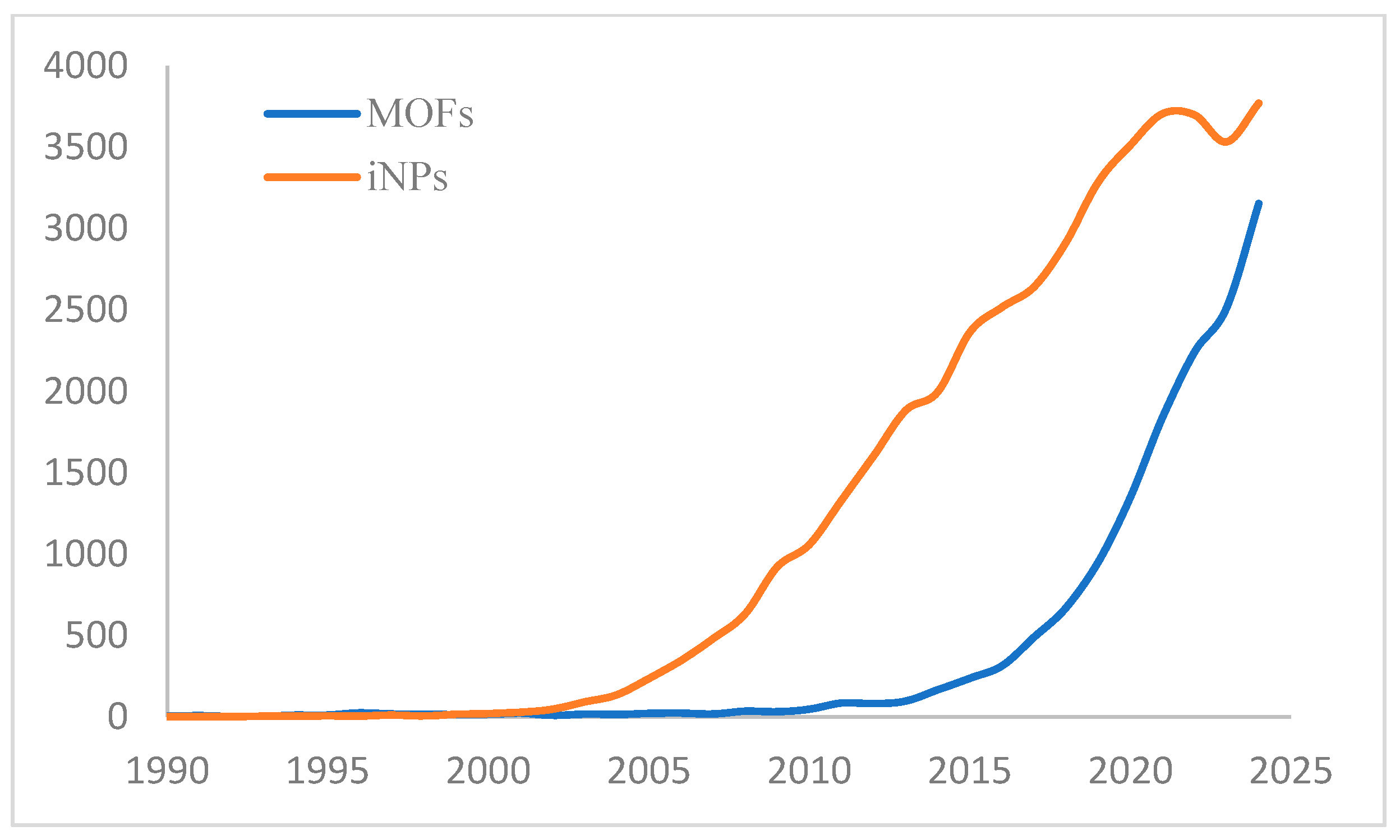
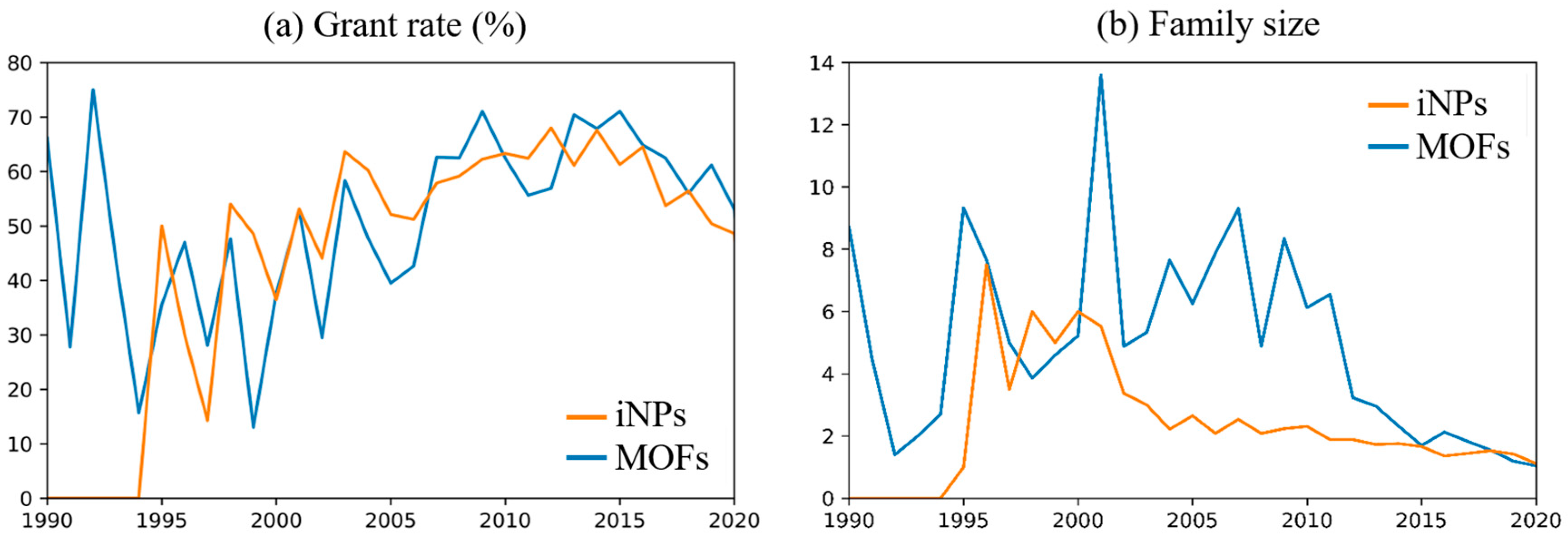
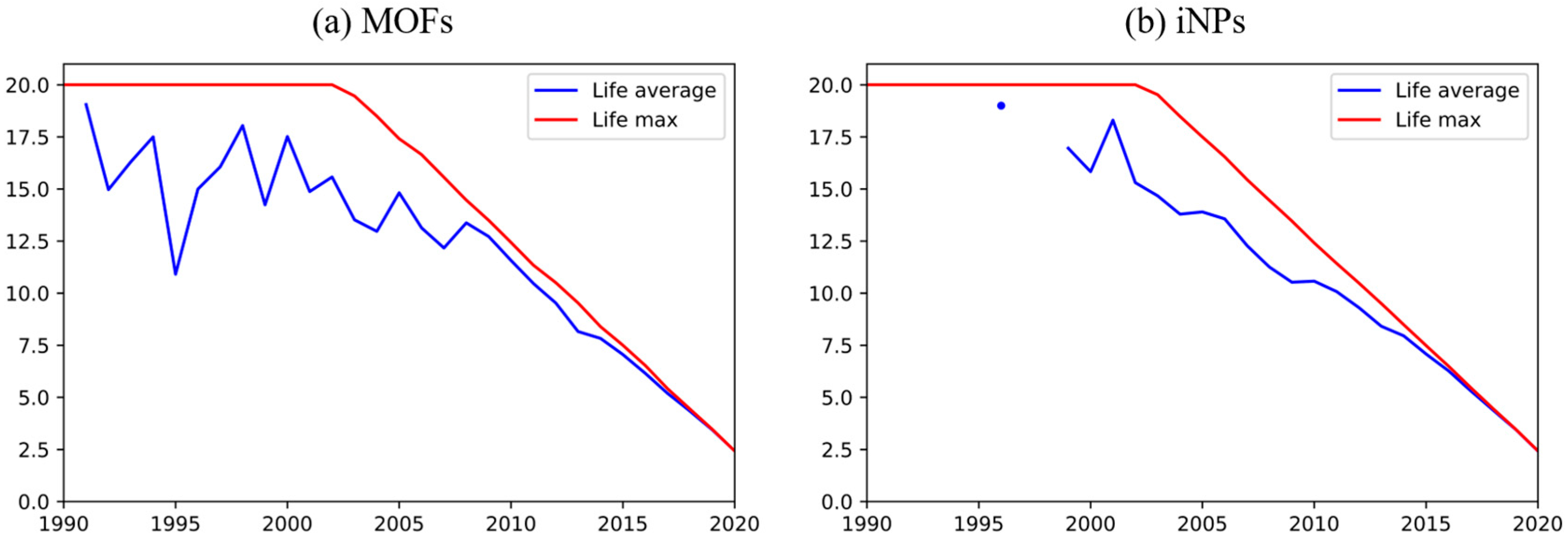
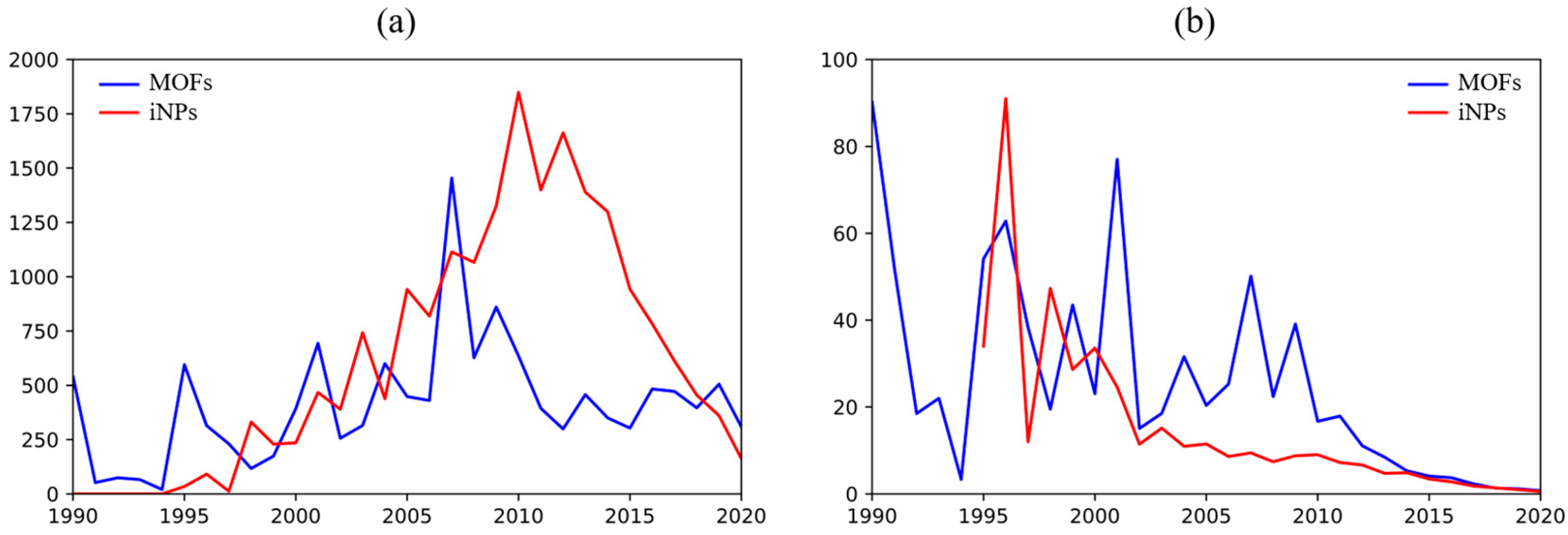
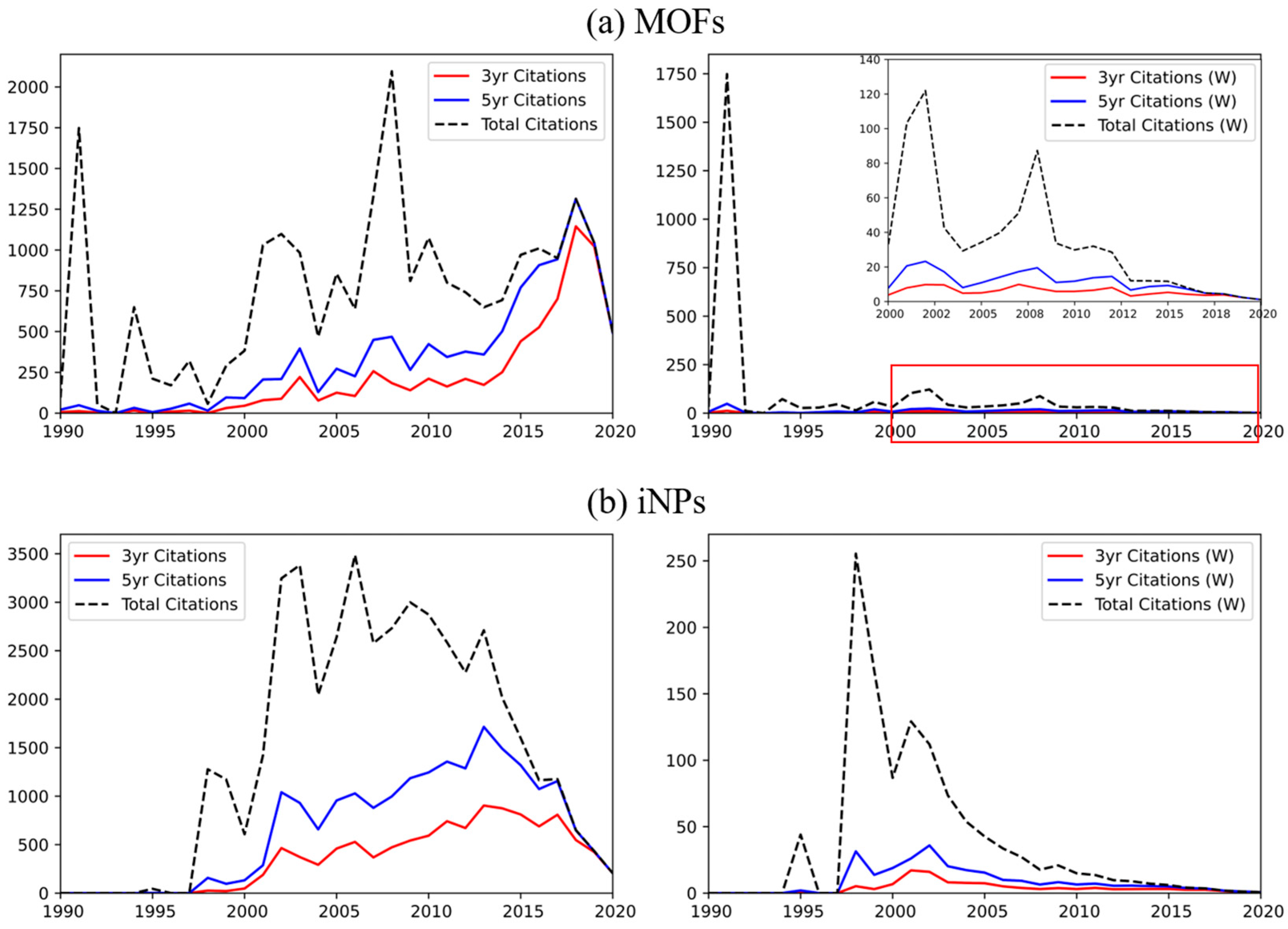
Disclaimer/Publisher’s Note: The statements, opinions and data contained in all publications are solely those of the individual author(s) and contributor(s) and not of MDPI and/or the editor(s). MDPI and/or the editor(s) disclaim responsibility for any injury to people or property resulting from any ideas, methods, instructions or products referred to in the content. |
© 2025 by the authors. Licensee MDPI, Basel, Switzerland. This article is an open access article distributed under the terms and conditions of the Creative Commons Attribution (CC BY) license (https://creativecommons.org/licenses/by/4.0/).
Share and Cite
Matera, U.M.; Faccenda, M.; Pérez, Y.; Picchi, D.F.; Rossi, L.; Larreina, S.; Horcajada, P. Quantifying Innovation: Intellectual Property Data as Indicators of Technology Maturity of Metal–Organic-Frameworks and Inorganic Nanoparticles. Inventions 2025, 10, 107. https://doi.org/10.3390/inventions10060107
Matera UM, Faccenda M, Pérez Y, Picchi DF, Rossi L, Larreina S, Horcajada P. Quantifying Innovation: Intellectual Property Data as Indicators of Technology Maturity of Metal–Organic-Frameworks and Inorganic Nanoparticles. Inventions. 2025; 10(6):107. https://doi.org/10.3390/inventions10060107
Chicago/Turabian StyleMatera, Umberto Maria, Matteo Faccenda, Yolanda Pérez, Darina Francesca Picchi, Lorenzo Rossi, Sergio Larreina, and Patricia Horcajada. 2025. "Quantifying Innovation: Intellectual Property Data as Indicators of Technology Maturity of Metal–Organic-Frameworks and Inorganic Nanoparticles" Inventions 10, no. 6: 107. https://doi.org/10.3390/inventions10060107
APA StyleMatera, U. M., Faccenda, M., Pérez, Y., Picchi, D. F., Rossi, L., Larreina, S., & Horcajada, P. (2025). Quantifying Innovation: Intellectual Property Data as Indicators of Technology Maturity of Metal–Organic-Frameworks and Inorganic Nanoparticles. Inventions, 10(6), 107. https://doi.org/10.3390/inventions10060107







